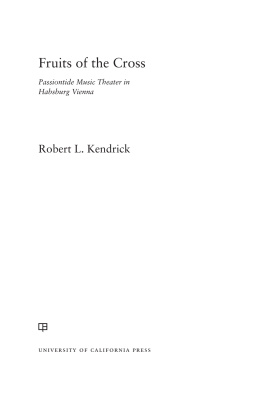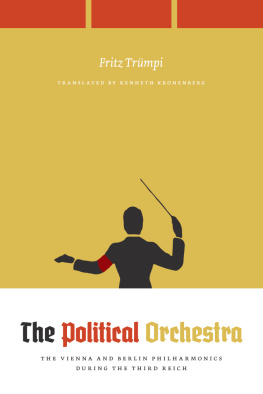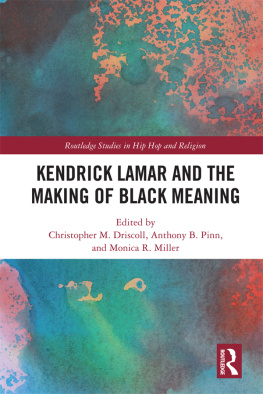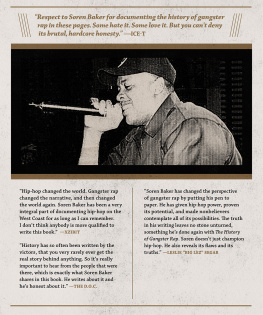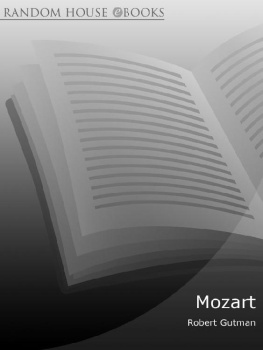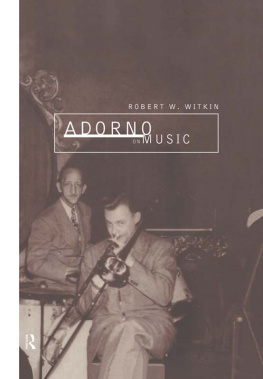Fruits of the Cross
The publisher gratefully acknowledges the generous support of the Margarita M. Hanson Endowment of the American Musicological Society, funded in part by the National Endowment for the Humanities and the Andrew W. Mellon Foundation.
The publisher and the University of California Press Foundation gratefully acknowledge the generous support of the Constance and William Withey Endowment Fund in History and Music.
Fruits of the Cross
Passiontide Music Theater in Habsburg Vienna
Robert L. Kendrick

UNIVERSITY OF CALIFORNIA PRESS
University of California Press, one of the most distinguished university presses in the United States, enriches lives around the world by advancing scholarship in the humanities, social sciences, and natural sciences. Its activities are supported by the UC Press Foundation and by philanthropic contributions from individuals and institutions. For more information, visit www.ucpress.edu.
University of California Press
Oakland, California
2019 by Robert L. Kendrick
Library of Congress Cataloging-in-Publication Data
Names: Kendrick, Robert L., author.
Title: Fruits of the cross : Passiontide music theater in Habsburg Vienna / Robert L. Kendrick.
Description: Oakland, California : University of California Press, [2019] | Includes bibliographical references and index. |
Identifiers: LCCN 2018023733 (print) | LCCN 2018027723 (ebook) | ISBN 9780520969872 (E-book) | ISBN 9780520297579 (cloth : alk. paper)
Subjects: LCSH : SepolcriAustriaVienna17th centuryHistory and criticism. | Habsburg, House ofHistory17th century. | Dramatic musicEurope, Central17th centuryHistory and criticism.
Classification: LCC ML 3222.2 (ebook) | LCC ML 3222.2 . K 46 2019 (print) | DDC 782.2/4dc23
LC record available at https://lccn.loc.gov/2018023733
Manufactured in the United States of America
27 26 25 24 23 22 21 20 19 18
10 9 8 7 6 5 4 3 2 1
The design here [the lament of the Three Marys at Christs Tomb in medieval English plays] is a kind of dramatic action which some modern definitions of action would altogether exclude: the action of a structure of feeling, expressed in a rhythmic pattern, of dramatic speech at a gained point of stillness and intensity.
Raymond Williams, Drama in Performance
Contents
Illustrations
Music Examples
1.1.
2.1.
2.2.
2.3.
3.1.
3.2.
3.3.
3.4ab.
4.1.
4.2ab.
4.4.
4.5.
4.6.
5.1.
5.2.
Acknowledgments
My first debt is to the staff of the Austrian National Library, especially that of the Musiksammlung, and that of the Wien-Bibliothek, along with the sterreichische Staatsarchiv at its two branches, including the Haus-, Hof- und Staatsarchiv. I am also grateful to Dr. Rudi Risatti and Dr. Thomas Trabitsch at the sterreichisches Theatermuseum, and to Dr. Andreas Gamerith at the library of Stift Zwettl. Further thanks are due to Franco Colussi, Rubens Bertini, and Tommaso Sabbatini for checking on various matters in Italy. But this book could not have been finished without the aid of Austrian colleagues: Martin Eybl, Gernot Mayer, and Franz Eybl. The previous work on the overall Viennese repertory by Herbert Seifert, Steven Saunders, Alfred Noe, Andrea Sommer-Mathis, Harry White, Marko Deisinger, idem zel, and Janet Page has been of enormous aid, and I strongly recommend reading their works in conjunction with the present study. For art-historical advice, I am indebted to Alice Jarrard and Walter Melion; for expert wisdom in historical acoustics, to Dorothea Baumann; and for guidance in political history, to Georg Michels and Gianvittorio Signorotto. My thoughts about tonal constructs in this repertory are predicated on the fundamental work of Gregory Barnett and Michael Dodds. Helpful critiques of chapters were provided by my 201617 colleagues at the Franke Institute for the Humanities, not least its director, James Chandler, and by the readers for the University of California Press. Just as the final version went in, the performance of Le Memorie dolorose by New York Citys Tenet and Acronym ensembles gave me the privilege of hearing one of these rare works come to life, for which I am grateful to Kivie Cahn-Lipman and Jolle Greenleaf. For counsel in literary matters, I thank Armando Maggi, Erminia Ardissino, and Eugenio Refini. At a key point, Jonathan Glixon encouraged me to tackle prejudice in the texts head-on. I remember Ray Gadke, who, alas, passed away just as the manuscript was completed, for his unending help with microfilms and many other library moments. Other individuals and institutions were also vital sources of information: the Biblioteca Federiciana of Fano; Dr. Angela De Benedictis at the Paul-Sacher-Stiftung; Michele Chiappini; the Archivio Segreto Vaticano; Nicoletta Pisu in Trent; and, for special help in Mantua, Licia Mari at the Archivio Storico Diocesano. I am grateful to Andrew McManus for running the music examples, and to Clare Snarski for Photoshop expertise. As always, Lucia Marchi has aided the books gestation in many ways.
One other scholar, from the past, deserves commemoration here. It must not have been easy for Flora Biach-Schiffmann, older than the other students and from a Jewish family, to complete her dissertation in art history at the University of Vienna in the 1920s on Giovanni and Ludovico Burnacinis set designs for operas, oratorios, and sepolcri, given that the faculty members Professor Josef Stryzgowski and his Assistent Karl Ginhart espoused racist theories or were even Nazi Party members. Still, she published her work in 1931, and it remains the starting point for work on theater design in this repertory. Along with her husband, she was deported from the temporary mass housing for Jews in Viennas Second District, via the Aspergbahnhof, to Theresienstadt on 22 July 1942 and was murdered on 13 October of that year. At a moment when many phantoms of hate have come back to haunt Europe and North America, remembering past wrongs becomes more important than ever.
Abbreviations and Notes on Sources
ASDMant | Archivio Storico Diocesano, Mantua |
ASMant | Archivio di Stato, Mantua, Archivio Gonzaga |
ASMod | Archivio di Stato, Modena |
ASV, Germania | Archivio Segreto Vaticano, Segreteria di Stato, Germania |
A-Wn | Vienna, sterreichische Nationalbibliothek (standard siglum from RISM; for other sigla see below) |
DBI | Dizionario biografico degli italiani (Rome, 1960; online at www.treccani.it) |
HHStA | Haus-, Hof- und Staatsarchiv, Vienna (Minoritenplatz); ZA=ltere Zeremonialakten; AZP=Alte Zeremoniellprotokolle; HK=Hofkorrespondenz |
StA | sterreichische Staatsarchiv, Vienna (Erdberg); FHKA= Finanz- und Hofkammeramt (therein: HZAB=Hofzahlamtsbcher; available at www.oesta.gv.at/site/6662/default.aspx) |
All the musical scores of Leopolds Schlafkammerbibliothek in A-Wn have been digitized and are available at lists the home tonal centers of the surviving repertory according to this terminology, a practice used also in the text.
Libraries bear the standard RISM sigla, available at www.rism.info/en/sigla. Historical information on Vienna in and out of the Hofburg, if not cited specifically, has been taken from F. Czeikes Historisches Lexikon Wien (Vienna, 199297), online at http://www.digital.wienbibliothek.at/wbrobv/content/titleinfo/1112764. In order not to confuse readers, I have employed the forms Eleonora Gonzaga (II, of Mantua/Nevers, 163086) and Eleonore Magdalene (of the Palatinate/Neuburg, 16551720) for Leopold Is stepmother and third wife, respectively. All translations are mine.
Next page
